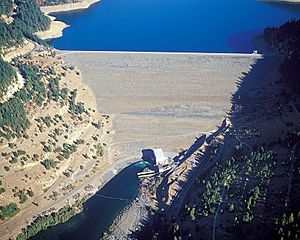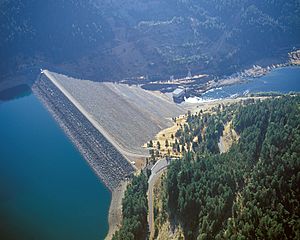Trinity Dam facts for kids
Quick facts for kids Trinity Dam |
|
|---|---|
 |
|
| Country | United States |
| Location | Whiskeytown-Shasta-Trinity National Recreation Area, Trinity County, California |
| Coordinates | 40°48′04″N 122°45′48″W / 40.80111°N 122.76333°W |
| Construction began | 1957 |
| Opening date | 1962 |
| Owner(s) | U.S. Bureau of Reclamation |
| Dam and spillways | |
| Type of dam | Earthfill |
| Impounds | Trinity River |
| Height | 538 ft (164 m) |
| Length | 2,450 ft (750 m) |
| Spillway type | Morning glory |
| Spillway capacity | 22,400 cu ft/s (630 m3/s) |
| Reservoir | |
| Creates | Trinity Lake |
| Total capacity | 2,447,650 acre⋅ft (3,019,130 dam3) |
| Inactive capacity | 400,000 acre⋅ft (490,000 dam3) |
| Catchment area | 692 sq mi (1,790 km2) |
| Surface area | 17,722 acres (7,172 ha) |
| Power station | |
| Hydraulic head | 426 ft (130 m) |
| Turbines | 2x Francis |
| Installed capacity | 140 MW |
| Annual generation | 424,192,000 kWh (2001–2012) |
Trinity Dam is a huge earth dam on the Trinity River in California, USA. It's about 7 miles (11 km) northeast of Weaverville. This dam was finished in the early 1960s.
It's part of a big project called the Central Valley Project. Its main job is to send water to farms in the dry San Joaquin Valley.
Trinity Dam stands 538 feet (164 meters) tall. It creates Trinity Lake, which is California's third largest reservoir. This lake can hold over 2.4 million acre-feet of water. The dam also has a power plant that makes electricity. Plus, it helps control floods in the Trinity and Klamath river areas.
Right below Trinity Dam is another lake called Lewiston Lake. A second dam forms this lake. From Lewiston Lake, water travels through a 10.7-mile (17.2 km) tunnel to the Sacramento Valley.
Contents
Why Was Trinity Dam Built?
In the early 1900s, California faced a big drought. There was also a tough economic time called the Great Depression. To help with these problems, the U.S. government started the Central Valley Project (CVP) in 1935. This project built dams and canals to bring water to California's Central Valley.
One idea in 1942 was to move water from the Trinity River. This would add more water to the CVP system. This part of the project was called the Trinity River Division.
Later, in 1951, the U.S. Bureau of Reclamation (USBR) took over the project. They planned a system of four dams and two tunnels. This system would collect water from the Trinity River. Then, it would send the water to the Sacramento River. It would also make extra electricity. Trinity Dam was the most important part of this plan. It would hold a lot of water. This water would then flow steadily to Lewiston Dam. Lewiston Dam is where the water starts its journey to the Central Valley.
Building the Dam
Work on Trinity Dam started on June 4, 1956. First, they dug out the area. Then, on July 8, 1957, the river was moved around the construction site.
Building was slow in late 1957 because the river flooded. The flood washed away a temporary dam that protected the site. But workers cleared the area by summer 1958. This delay also gave them time to line the water tunnel with concrete.
They began placing rocks for the main dam in 1957. In 1959, they added a very long conveyor belt, about 11,000 feet (3,400 meters) long. This made moving rocks to the dam much faster. The tunnel for the spillway was finished in October 1959. The main dam structure was completed in late 1960. However, the dam's power plant wasn't ready until December 1963.
For a while, Trinity Dam was the tallest earthfill dam in the world. But in 1968, Oroville Dam in California became even taller. Oroville Dam is still the tallest dam in the United States.
As the lake filled up, it covered old towns like Trinity Center and Minersville. Parts of an old stagecoach road also went underwater. The lake was first named Clair Engle Lake. This was after Clair Engle, a senator who supported the project. But local people didn't like this name. Many had lost their homes to the rising water. So, in 1995, the lake was renamed Trinity Lake.
How Trinity Dam Works
Trinity Dam is made of earth and rocks. It uses river gravel and local stone. The dam rises 538 feet (164 meters) from its base. It is 440 feet (134 meters) above the riverbed. The top of the dam is 2,450 feet (747 meters) long. It sits 2,395 feet (730 meters) above sea level.
The dam has three ways to release large amounts of water. The main water outlets can release 24,000 cubic feet (680 cubic meters) of water per second. The main spillway, which looks like a giant bell, can handle 22,400 cubic feet (634 cubic meters) per second. There's also an extra spillway that can release 2,250 cubic feet (64 cubic meters) per second.
Trinity Lake can hold up to 2,447,650 acre-feet of water when full. It covers an area of 17,722 acres (7,172 hectares). The Trinity Powerplant is at the bottom of the dam. It has two Francis turbines. Together, they can make 140 megawatts (MW) of power. This is an upgrade from their original 100 MW capacity. The plant usually makes 358.97 million kilowatt hours (kWh) of electricity each year. It mainly works as a peaking plant, meaning it runs when electricity demand is highest.
Helping Salmon
Trinity Dam is a big wall that salmon cannot pass. This means they can't swim upstream to lay their eggs. The dam and other parts of the project have also harmed salmon in the lower river.
Within ten years of the dam being built, over three-quarters of the Trinity River's water was sent away. The small amount of water left in the river was warm and shallow. This was not good for salmon trying to lay eggs. Also, the dam stops the river's natural floods and sediment. This harms the gravel beds that salmon need for their homes.
To help the salmon, the USBR built the Trinity River Fish Hatchery. This hatchery is run by the California Department of Fish and Game. It can raise 40 million fish eggs. In 1992, a law was passed to help. It made sure that at least 340,000 acre-feet of water would be released into the lower Trinity River each year.
Below Trinity Dam, there is also the Lewiston Dam (California). Water from Lewiston Dam is sent to other places. This water is used by farms and cities across the state. So, two dams work together to move water from the reservoir to people who need it.
Fun at Trinity Lake
Trinity Lake has 145 miles (233 km) of shoreline. This makes it a popular place for people in Northern California to visit in the summer. Since 1965, the lake has been part of the Trinity Unit of the Whiskeytown-Shasta-Trinity National Recreation Area.
The lake has places for boats and marinas. Most of these are in the Stuart Fork area and near the town of Trinity Center.
Images for kids



